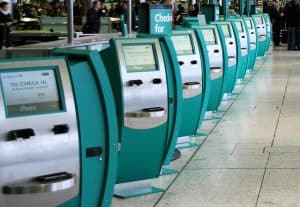
There is a growing trend for passenger automation within airports, and for good reason. A new report published by IT provider SITA has revealed that “the demands of the growing number of tech-savvy travellers will have the biggest impact on the digital plans of airports and airlines over the next six years”. By 2025, 68% of passengers will be digital travellers. They will expect travel through airports to offer the same conveniences, controlling their experience digitally through their mobile devices, as every other aspect of their lives.
Automation within airports improves passenger experience
Passenger automation is the movement of passengers throughout the airport using technology, with limited human interaction. The passenger uses their mobile device or technology within the airport to go through the many steps in the process – self check in, bag drop, boarding and gate information, and so on.
The technological innovations that create the automation enable passengers to carry out each important step while travelling at their own convenience, whether they want to check-in online a week before their flight, do their own bag drop to avoid queues, or eat a meal airside without having to move to check their flight details every few minutes. And everything that is for the passengers’ benefit is also beneficial for the airport. Online check-in reduces queues and congestion, bag drops fulfills a similar function, passenger flows can be managed to minimise congestion at security, and retail/F&B outlets benefit from additional income.
This can, and does, include biometrics – creating biometric travel tokens for security, at boarding and at border control. This is another key area of technology development and growth to be explored in our later.
Why are airports investing in automation?
Automation in airports is a response to rising passenger numbers and the challenges of capacity constraints. IATA predicts that by 2037, passenger numbers could double to 8.2 billion. To cope with these increasing numbers of passengers, airports can look to automation to provide flexibility and realise capacity. Watch our recent video
Technology such as CUPPS (Common Use Passenger Processing Systems), for example, allows airports to share equipment between airlines and ground handlers. This reduces the need for individual physical check-in or gate podium positions for each airline. With CUSS (Common Use Self Service) kiosks, the check in is shared between airlines and the passengers themselves take care of most of the administration, to the benefit of the airport, airline and passengers for ease of use, speed and capacity.
With growing passenger numbers, centralised common-use technology provides airports with the flexibility to solve challenges of scale. Dependent on schedule, airports can adjust kiosks, gates and check in equipment to meet the demands of passenger numbers on the day, rather than keeping the airport ready for full capacity.
How can AiQ Consulting help your airport?
Investing in automation is crucial for airports, but it is not without risk, especially in its implementation and the impact that it can have on the passenger journey. AiQ Consulting’s knowledge will allow you to feel secure in your investment and make the right decisions. We simulate clear scenario models showing the impact of new technology, replicating your airport’s activity and running future scenarios to see how the change will affect airport capacity.
Our bespoke modelling and simulation software, TransvisionAiR™ enables smart decision-making through a choice of outputs – spreadsheets, graphs, 2D and 3D animation, as well as virtual reality. This allows you to bring your data to life, test the effects of automation, and gain unique insights across your operation.
Our experience will also determine how any changes will impact your airport holistically and suggest where changes can be made to rectify this. Our modelling of passenger flows can recognise where there will be congestion and where IATA standards will be challenged, and we can help you address this with our complete airport knowledge. We help you see the bigger picture and future-proof your airport.
To find out more about automation and how it could benefit your airport, contact us today.

